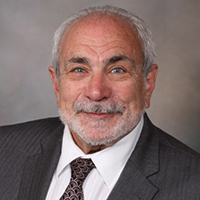ACCEL: Impact of Optimal Medical Therapy in the Dual Antiplatelet Therapy Study

Allan S. Jaffe, MD, FACC, interviewed Charles Resor, MD, about an analysis of the impact of optimal medical therapy (OMT) in patients enrolled in the Dual Antiplatelet Therapy (DAPT) study.
Dr. Jaffe: Dr. Resor, would you start by reminding us of the design of the DAPT study?

Dr. Resor: The DAPT Study randomized approximately 11,000 patients who underwent drug-eluting or bare-metal stent placement and then were free of ischemic or bleeding complications for 12 months to an additional 18 months of continued thienopyridine therapy (standard dose clopidogrel and prasugrel) versus placebo.
How was OMT defined for this analysis?
We defined OMT according to ACC/American Heart Association Class I indications, such that all patients had an indication for a statin, angiotensin-converting enzyme (ACE) inhibitor or angiotensin-receptor blocker (ARB) or a beta-blocker.
Did you look at doses or you just whether the patient was on or off therapy at the time of randomization?
We did not have information on medication dosing, so it was just being either on or off those agents at the time of randomization, which was 12 months after the index PCI.
If they came off [these drugs] subsequently, did they change group?
They stayed in the initial group.
What endpoints were you specifically interested in?
We were most interested in major adverse cardiac events (MACE), a composite of myocardial infarction (MI), stroke or death, as well as GUSTO moderate or severe bleeding.
What, in general, did you find?
The primary results of our study were that the use of OMT had no impact on the treatment benefit and risk of continuing a thienopyridine, such that continued thienopyridine use resulted in consistent reductions in ischemic endpoints and consistent increases in bleeding endpoints in this population.
Were the groups the same or were there differences?
There were significant differences between the groups. Patients who were on OMT tended to be younger, and they tended to have lower rates of hypertension, chronic kidney disease and prior PCI or MI.
We would then expect that they would have lower event rates.
That is correct. There were significant differences between the groups. For our comparison of the treatment effect within those two groups, we adjusted our interaction p value for approximately 20 baseline characteristics, procedural characteristics and stent-related factors.
Can you give us some sense of the magnitude of these differences?
There were some significant differences. There was approximately a ten percent higher rate of hypertension in patients who were not on OMT compared with on OMT.
How about the results in terms of MI and MACE?
The hazard ratio for the reduction in MI for patients with continued thienopyridine on OMT was about 0.6, while the hazard ratio in the off-OMT group was about 0.4. While there is some suggestion that the patients off OMT derived a somewhat greater benefit, our interaction analysis showed that the interaction p value did not meet our criteria for significance, suggesting there is a consistent treatment effect between the two groups.
Were the absolute rates different between the OMT and no OMT groups?
There were significant differences in the rates of all three outcomes between the groups.
Was there a cost in terms of bleeding?
For the outcome of GUSTO moderate or severe bleeding, the patients off OMT had higher bleeding rates irrespective of the treatment arm. But, when randomized to continued thienopyridine use, there was no difference in the increase in hazard and bleeding between the on- and off-OMT groups.
Was there a difference between clopidogrel and prasugrel?
Within the primary results of the DAPT Study, there were no differences in ischemic or bleeding outcomes between the two thienopyridines. For this analysis, our results were not different when we adjusted for the particular thienopyridine.
Although you didn’t see more detriment, you didn’t see more benefit with prasugrel, which is of interest.
We didn’t specifically look to compare outcomes by thienopyridine, but we did not see a difference in event rates in our adjusted and unadjusted analyses.
Was there any signal that the various doses of aspirin affected these results?
We didn’t specifically look at that in our analysis, but the primary results did not show any significant heterogeneity between the two doses, based on prior reports of the DAPT Study and the supplementary appendix.
A patient could be off OMT because of missing either an ACE inhibitor, ARB, beta-blocker or a statin. Did you see any differences in terms of which drug was not present that defined a patient as off OMT?
When we looked at the treatment benefit of continued thienopyridine across patients who were on or off a statin, beta-blocker, or ACE inhibitor or ARB we did not see any significant differences. [We observed] no significant heterogeneity between the two groups when looking at the treatment benefit of continued thienopyridine.
Were there differences in the absolute rates across the groups?
There were differences in relation to being on or off individual components of OMT. It appeared there was a significant difference in outcomes in patients on or off a statin. Similarly, there was a difference for being on or off a beta-blocker, but less so for the use or not of an ACE inhibitor or ARB. However, the comparison of being on or off the components of OMT was not randomized, so we think there is a significant potential for residual confounding. We feel somewhat less strong about drawing conclusions from those comparisons than we do about saying that there’s a consistent treatment benefit across the groups.
Certainly reasonable. Where do we go from here?
The main conclusion of our paper is that the decision to continue DAPT beyond 12 months should be made irrespective of OMT use.
And because the rates were likely somewhat lower in the OMT group regardless of the status of continuing a thienopyridine, you would certainly urge OMT.
Absolutely. We would always say your focus should be placed on continuing OMT as much as possible. However, whether or not patients are on OMT should not impact the decision to continue DAPT beyond 12 months.
This interview was edited for print from an interview transcript.
References
- Mauri L, Kereiakes DJ, Yeh RW, et al. N Engl J Med 2014;371:2155-66.
- Resor CD, Nathan A, Kereiakes DJ, et al. Circulation 2016;134:989-98.
Keywords: ACC Publications, Cardiology Magazine, Adrenergic beta-Antagonists, American Heart Association, Angiotensin-Converting Enzyme Inhibitors, Aspirin, Hydroxymethylglutaryl-CoA Reductase Inhibitors, Hypertension, Myocardial Infarction, Renal Insufficiency, Chronic, Stroke, Thienopyridines, Ticlopidine
< Back to Listings

